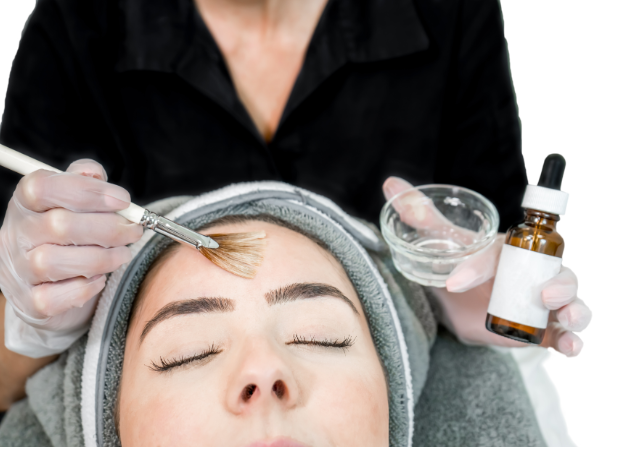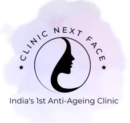
Best Clinic For Chemical Peels In Malleshwaram, Bangalore
Sessions
2 - 3
Duration
20 minutes
Frequency
Monthly Once
Results
In 2 Weeks
Numbing Cream
Not required
Social downtime
6 Days
Time off work
None
Sport
1 Day
Sessions
2 - 3
Duration
20 minutes
Frequency
Monthly Once
Sport
1 Day
Results
In 2 Weeks
Numbing cream
Not required
Social downtime
6 Days
Time off work
None
Your skin may get dry and rough because of the weather in Malleshwaram, Bangalore. As your skin loses the natural glow, you may feel less confident about your appearance. At CNF in Malleshwaram, Bangalore, you can acquire the lost glow in your skin with our advanced chemical peel treatment. With the implementation of the most effective techniques and tools, our doctors strive to deliver long-term visible results. During the consultation, we thoroughly check your skin to identify your unique concerns and customize the chemical peel treatment as required.
Our chemical peel of various strengths targets different skin issues, such as pigmentation, acne, and fine lines. We decide the required strength of chemical peel to fix your skin issues. Our experts ensure to do the peeling carefully and perfectly. The chemical peel based on the advanced skincare approach is more than only a skin treatment but a rejuvenating process. At our clinic, customized chemical peels depending on your skin concerns add a youthful
charm to your skin.
How effective our Chemical Peels are?
Chemical peels are generally effective at improving the appearance of the skin, but the results can vary depending on the type of peel used and the severity of the skin concerns being treated.
Superficial peels, also known as lunchtime peels, are the mildest form of chemical peel and are typically used to improve the appearance of mild acne, acne scars, and uneven skin tone. These peels only affect the outermost layer of the skin and generally produce subtle results.
Medium-depth peels, on the other hand, penetrate deeper into the skin and can be used to treat more severe acne scars, sun damage, and uneven skin tone. These peels can produce more noticeable results, but they also require a longer recovery time and may cause some redness and swelling.
Deep peels, which penetrate the deepest layers of the skin, can be used to treat severe skin concerns such as deep wrinkles and severe sun damage. These peels can produce the most dramatic results, but they also have the longest recovery time and carry the greatest risk of complications.
Benefits Of Chemical Peel Treatments
Some of the benefits of chemical peel treatments include:
- Improving the appearance of the skin: Chemical peels can help improve the texture and tone of the skin, giving it a more youthful and radiant appearance.
- Reducing the appearance of acne and acne scars: Superficial chemical peels can help reduce the appearance of mild acne and acne scars.
- Treating sun damage: Chemical peels can help improve the appearance of sun-damaged skin by removing the top layers of damaged skin.
- Improving uneven skin tone: Chemical peels can help even out the skin tone by removing hyperpigmentation, such as age spots and melasma.
- Reducing the appearance of fine lines and wrinkles: Chemical peels can help reduce the appearance of fine lines and wrinkles, especially when combined with other anti-aging treatments.
- Enhancing the absorption of skincare products: After a chemical peel, the skin is more receptive to skincare products, which can help improve their effectiveness.
It’s important to note that chemical peels are not a one-time treatment and typically require multiple sessions to achieve the desired results. The number of treatments needed will depend on the type of peel and the condition of your skin.
How Does Chemical Peel Help In Scars & Pimples?
Chemical peels can help improve the appearance of scars and pimples by removing the top layers of damaged or scarred skin. This stimulates the production of new skin cells, which can help reduce the appearance of scars and improve the overall texture and tone of the skin.
There are different types of chemical peels that can be used to treat scars and pimples, including superficial peels and medium-depth peels. Superficial peels, also known as lunchtime peels, are the mildest form of chemical peel and are typically used to improve the appearance of mild acne and acne scars. These peels only affect the outermost layer of the skin and generally require minimal downtime.
Medium-depth peels, on the other hand, penetrate deeper into the skin and can be used to treat more severe acne scars. These peels can be more effective at improving the appearance of scars, but they also require a longer recovery time and may cause some redness and swelling.
It’s important to keep in mind that chemical peels are not a one-time treatment and typically require multiple sessions to achieve the desired results. The number of treatments needed will depend on the severity of the scars and the type of peel used.
Microdermabrasion Vs. Chemical Peel
Both microdermabrasion and chemical peels can be effective treatments for improving the appearance of the skin, but they work in different ways.
Microdermabrasion is a non-invasive procedure that uses a handheld device to exfoliate the top layers of the skin. The device uses fine crystals to gently remove the outermost layer of the skin, revealing the smoother, more youthful-looking skin underneath. Microdermabrasion is typically used to improve the appearance of fine lines and wrinkles, uneven skin tone, and mild acne scars.
Chemical peels, on the other hand, use a chemical solution to exfoliate the top layers of the skin. The solution is applied to the skin, causing it to peel off, revealing the new skin underneath. Chemical peels are used to treat a variety of skin concerns, including acne, acne scars, sun damage, uneven skin tone, and fine lines and wrinkles.
We usually mix the combination of both when going for a chemical peel.
Some of the chemical peel treatment results
Talk To Our Peel Expert Today!
No Obligations! Just jump on a quick call with our Peel expert and know what kind of treatment will suit you the best.
Either way you will get some actionable tips to reach your skin goals faster.
Why Clinic Next Face?

Experienced in-house team of certified cosmetic doctors and a huge network of dermatologists, surgeons, nutritionists, PMU Artists, cosmetologists, and other medical professionals.

Free Hair & Skin Assessment by the experts in the industry.

Advanced FDA approved equipments along with well trained doctors.

Served 1,00,000 happy customers and counting

India's First Smart-Ageing Clinic which takes holistic approach to make reverse all signs of physical ageing.

We commit to provide customized treatments and setting right expectations before treatments.
Frequently Asked Questions On Chemical Peel Treatment
Chemical peels are generally considered safe when performed by a trained and experienced doctor. However, as with any medical procedure, there are potential risks and side effects that you should be aware of.
Some common side effects of chemical peels include redness, swelling, and flaking of the skin. These side effects are usually temporary and resolve on their own within a few days. More serious complications are rare, but can include scarring, infection, and changes in skin color.
To minimize the risk of complications, it’s important to follow your doctor’s instructions carefully before and after the procedure. This may include avoiding certain skincare products, using sun protection, and avoiding activities that could cause sweating or irritation.
Yes, chemical peels can help remove tanning from the skin. Tanning is caused by an excess of the pigment melanin in the skin, which is produced in response to sun exposure. Chemical peels can help remove the top layers of the skin, which can help lighten the skin and reduce the appearance of tanning.
There are different types of chemical peels that can be used to treat tanning, ranging from superficial peels to medium-depth peels. Superficial peels, also known as lunchtime peels, are the mildest form of chemical peel and are typically used to improve the appearance of mild sun damage and uneven skin tone. These peels only affect the outermost layer of the skin and generally require minimal downtime.
Yes, chemical peels can help improve the appearance of acne scars. Acne scars are caused by damage to the skin’s collagen and elastin, which can occur when acne is not treated properly. Chemical peels can help remove the top layers of the skin, which can help stimulate the production of new collagen and elastin, leading to smoother, more even-toned skin.
There are different types of chemical peels that can be used to treat acne scars, ranging from superficial peels to medium-depth peels. Superficial peels, also known as lunchtime peels, are the mildest form of chemical peel and are typically used to improve the appearance of mild acne scars. These peels only affect the outermost layer of the skin and generally require minimal downtime.
Do’s:
Follow your doctor’s instructions: Be sure to follow your provider’s instructions carefully after the treatment. This may include applying ointments or creams as directed, avoiding certain skincare products, and protecting your skin from the sun.
Keep your skin hydrated: It’s important to keep your skin hydrated after a chemical peel to help it heal properly. Use a gentle, non-irritating moisturizer as directed by your doctor.
Wear sunscreen: Chemical peels can make your skin more sensitive to the sun, so it’s important to wear sunscreen with a high SPF to protect your skin from further damage.
Avoid picking or scratching your skin: It’s important to avoid picking or scratching your skin after a chemical peel, as this can cause irritation and delay the healing process.
Don’ts:
Don’t expose your skin to the sun: Avoid spending extended periods of time in the sun after a chemical peel, as it can cause further damage to your skin. If you must be outside, be sure to wear sunscreen and protective clothing.
Don’t use exfoliating products: Avoid using exfoliating products, such as scrubs or loofahs, on your skin after a chemical peel. These products can irritate your skin and delay the healing process.
Don’t use hot water: Avoid taking hot showers or baths after a chemical peel, as hot water can cause irritation and dryness. Instead, use lukewarm water and a gentle, non-irritating soap.
Don’t use harsh skincare products: Avoid using harsh skincare products, such as toners or astringents, on your skin after a chemical peel. These products can irritate your skin and delay the healing process.
If you have any specific concerns about what to do or not do after a chemical peel, be sure to ask your healthcare provider for more information. They can provide you with personalized recommendations based on your individual needs.
Chemical peels may be able to lighten or remove beauty marks, also known as moles, but it is not a guaranteed treatment. Beauty marks are small, benign growths on the skin that are typically made up of cells called melanocytes, which produce the pigment melanin.
Chemical peels work by removing the top layers of the skin, which can help lighten or remove beauty marks that are located on the surface of the skin. However, beauty marks that are deeper in the skin or that are present at birth (congenital moles) may not be affected by chemical peels.
Chemical peels may be able to improve the appearance of stretch marks, but they are not a guaranteed treatment for removing stretch marks. Stretch marks, also known as striae, are narrow, indented streaks that appear on the skin when it is stretched beyond its normal limits. They can be caused by a variety of factors, including pregnancy, weight gain, and rapid growth during puberty.
Chemical peels work by removing the top layers of the skin, which can help improve the texture and tone of the skin and reduce the appearance of stretch marks. However, stretch marks that are deeper in the skin may not be affected by chemical peels.



